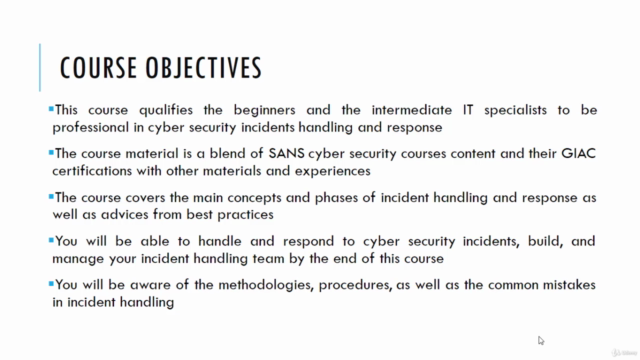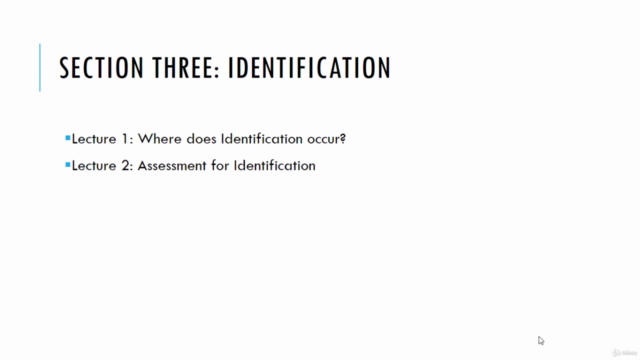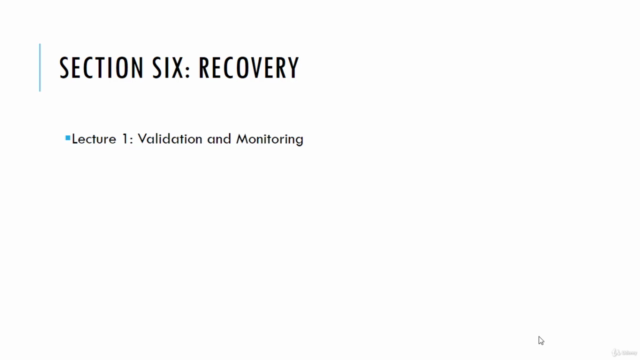Cybersecurity Incident Handling and Response

Why take this course?
🛡️ Master Cybersecurity Incident Handling & Response with Confidence!
🚀 Course Title: Cybersecurity Incident Handling and Response by Mohammad Adly
Are you ready to step into the world of cybersecurity incident handling and response? This comprehensive online course is tailored for aspiring and seasoned cybersecurity professionals who aim to lead a team through the complexities of security incidents with grace and efficiency. 🎓
Course Overview:
Introduction:
- Understand the fundamental concepts: what constitutes an event versus an incident, and why this distinction matters in the world of cybersecurity.
Phase 1 - Preparation:
- Learn about the critical steps taken before an incident occurs to prepare your team and systems.
- Discover how to build a robust cybersecurity team that can handle any challenge.
Phase 2 - Identification:
- Navigate through the process of detecting and assessing security incidents to determine their nature and scope.
Phase 3 - Containment:
- Gain insights into effective strategies for limiting the impact of a security breach.
- Understand both short-term and long-term actions that are crucial during this phase.
Phase 4 - Eradication:
- Focus on the critical steps to remove the threat completely from your systems.
- Learn how to strengthen your defenses after an incident to prevent future occurrences.
Phase 5 - Recovery:
- Master the techniques for bringing systems back online safely and effectively.
- Ensure that all attacked systems are fully functional and secure.
Phase 6 - Lessons Learned:
- Conclude the process with a detailed analysis to identify improvements and implement them.
- Share knowledge and experiences to enhance your team's skills and prevent future incidents.
What You Will Learn:
✅ The Six Phases of Incident Handling & Response:
- A structured approach to handle security incidents effectively.
- Practical steps to minimize the impact of cyber threats and data breaches.
✅ Cybersecurity Best Practices:
- Develop a strategic plan that addresses various incident scenarios.
- Learn how to enhance your organization's resilience against cyber threats.
✅ Real-world Experience:
- Engage with case studies and real-life scenarios that challenge you to apply your knowledge.
Who Is This Course For?
👥 This course is perfect for:
- Cybersecurity Officers
- Incident Handlers
- IT Professionals with a basic understanding of IT and a foundational knowledge of cybersecurity concepts.
Why Take This Course?
✨ Expert Instructor: Led by the esteemed Mohammad Adly, whose expertise in cybersecurity is unparalleled.
🔒 Practical Skills: Gain hands-on experience in incident handling and response that will make you an indispensable member or lead of any cybersecurity team.
📈 Real Impact: Learn how to build a robust IR plan that can fix potential vulnerabilities and prevent future attacks.
Enroll Now & Transform Your Cybersecurity Career!
Don't miss this opportunity to become an expert in handling and responding to cybersecurity incidents. Join our online course today and secure your place in the ever-evolving landscape of cyber defense. 🌐
Enroll Now and elevate your career to new heights!
Course Gallery




Loading charts...
Comidoc Review
Our Verdict
Incident Handling and Response offers a solid high-level overview of tackling cybersecurity incidents in your organization. Although it touches on essential components such as preparation, response, and recovery, the course falls short when it comes to engaging delivery and practical applicability. Its strength lies in emphasizing the development of sound business processes for threat management, but overall could benefit from case scenarios, real-world examples, and actionable content to boost its effectiveness.
What We Liked
- Highlights the importance of high-level business processes for threat management.
- Comprehensive presentation of incident handling stages from preparation to recovery.
- Covers best practices like avoiding blame culture in cybersecurity incidents.
Potential Drawbacks
- Monotonous presentation style with excessive reading from slides.
- Lacks real-world examples, interactive case scenarios, or actionable content.
- Presenter struggles with English and stumbles over words during the recording.
- Slides are text-heavy without visuals; organization could be improved.